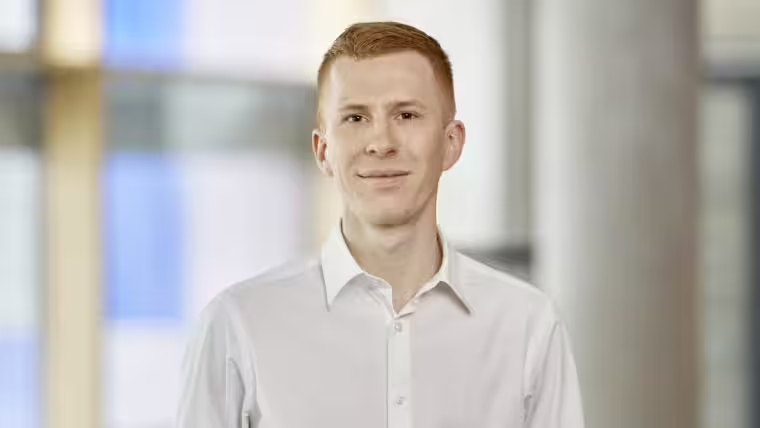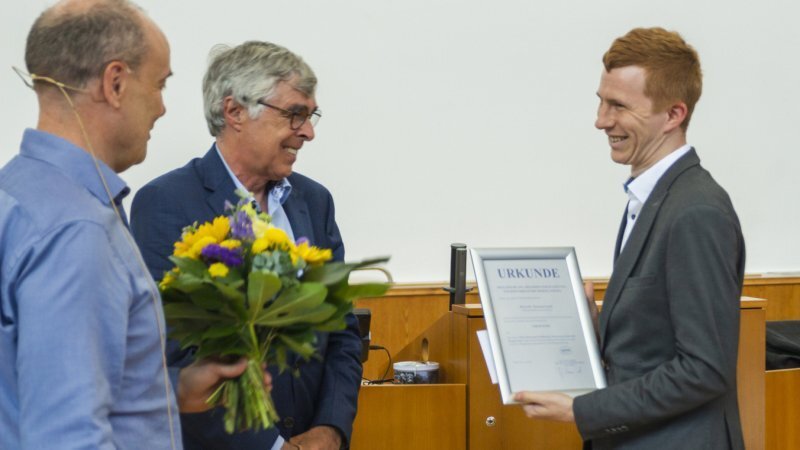
- Light
Published: | By: Ira Winkler, English translation by Gleb Chupakhin
Prof. Peschel, Dr. Schniewind and Dr. Goebel at the award ceremony on Alumni Day of the Physical-Astronomical Faculty.
Image: MK BoseaThorsten Albert Goebel of the Friedrich Schiller University Jena was awarded the Doctoral Prize of the Dr.-Ing. Siegfried Werth Foundation for Best Dissertation in The Field of Optical Metrology.
Dr. Goebel completed his doctorate under the supervision of ACP principal scientist Stefan Nolte on the topic "Femtosecond pulse-written fiber Bragg gratings as multi-channel filters." In his impressive work, he achieved significant advancements in the area of fiber Bragg gratings for optical filters and sensors for multicore fibers. The application areas are broad—ranging from narrowband and low-loss optical filters for sensing and spectroscopy to astronomy.
Groundbreaking Results
The starting point of his research was the development of a simulation tool for the calculation and optimization of complex grating structures, which enabled the realization of multi-resonant fiber Bragg gratings. The results showed that the complex grating structures of the so-called aperiodic fiber Bragg gratings are difficult to implement using the established phase mask technique and that these challenges have not yet been definitively solved. Even a developed highly complex phase mask did not yield the desired results within the fiber due to the diffraction effects of small structures. However, together with the research group led by Prof. Alexander Fuerbach from Macquarie University in Sydney, Australia, an approach was developed using a direct writing method. This laid the groundwork for successfully realizing an optimized setup for writing complex multi-resonant fiber Bragg gratings with up to 20 resonances. The next step he faced was overcoming the shadowing effects caused by the fiber cores in order to write fiber Bragg gratings in multicore fibers. Dr. Goebel addressed this challenge with a highly precise rotating writing process and a novel multicore fiber design developed in collaboration with the Fraunhofer IOF.
Mr. Goebel succeeded in realizing a filter overlapping all cores by combining the novel writing method with the adapted fiber design. This was the first experimental demonstration of a targeted fiber Bragg grating filter in a 12-core fiber. Thorsten Goebel thus ventured into uncharted scientific territory, as overcoming previous limitations allows new spectral ranges for optical filters and sensors to be explored in the future, enabling new spectroscopic and sensor applications. Mr. Goebel made a significant contribution to low-loss spectral filtering in various application scenarios with his research work. Important milestones for spectroscopy and 3D fiber sensing in particular were reached, and future applications under real conditions are conceivable.
Distinguished Achievements
During his doctorate, Goebel published 13 papers, filed two patents (one of which has already been granted), and completed a research stay in Australia. His outstanding scientific work was recognized already in 2018 with the "Best Student Presentation Award" at SPIE Photonics West.
Prof. Dr. Andreas Tünnermann praised Goebel's "excellent knowledge of fiber optics" and his "highly goal-oriented and consistent" working style. The awarding of the Doctoral Prize during Alumni Day of the Astronomical-Physical Faculty on June 7, 2024, honors Goebel's "significant contribution to low-loss spectral filtering in various application scenarios."
Visionary Motivation and Future Prospects
Thorsten Goebel's fascination with astronomy was a driving force behind his research. Inspired by the study of distant stars and planets, he focused on the near-infrared spectral range around 1500 nm, where the signatures of highly redshifted stars and exoplanets are found. One of the biggest challenges in this area is the emission from excited OH radicals in the Earth's atmosphere, which complicates the observation of the actual signals.
The goal of Goebel's work was to develop filters that very selectively suppress the OH lines while allowing the rest of the light to pass through. This filter function needed to be integrated into the fibers, as telescope signals are typically coupled into fibers anyway. To suppress many lines, Thorsten Goebel chose an aperiodic refractive index pattern and developed the aforementioned method for picometer-accurate inscription into the cores of special glass fibers.
The first use of the filters on a telescope is planned for the end of the year, highlighting the practical applications of his work. With his outstanding research, Thorsten Goebel has made significant contributions in the field of highly demanding metrology, making him a worthy and fitting recipient of this year's Siegfried Werth Prize.
